Cloud Computing in Business Development: A Detailed Analysis
VerifiedAdded on 2022/11/17
|25
|6408
|285
Report
AI Summary
This report delves into the impact of cloud computing on business development. It begins with an abstract highlighting cloud computing's role as a transformative technology offering secure and reliable services. The report provides a comprehensive literature review covering cloud computing technologies, including IaaS, PaaS, and SaaS models, and evaluates their critical aspects. It also explores the potential challenges faced by businesses adopting cloud computing and offers recommendations to mitigate these issues. The methodology section outlines the research philosophy, approaches, design, and data collection processes. Further, the report touches upon future research scopes and ethical considerations. The report aims to provide a detailed analysis of cloud computing's advantages, limitations, and practical applications in business organizations, ultimately providing strategies to leverage this technology effectively. Finally, the study intends to analyze the technologies and deployment models along with the challenges faced during the adoption of cloud computing.
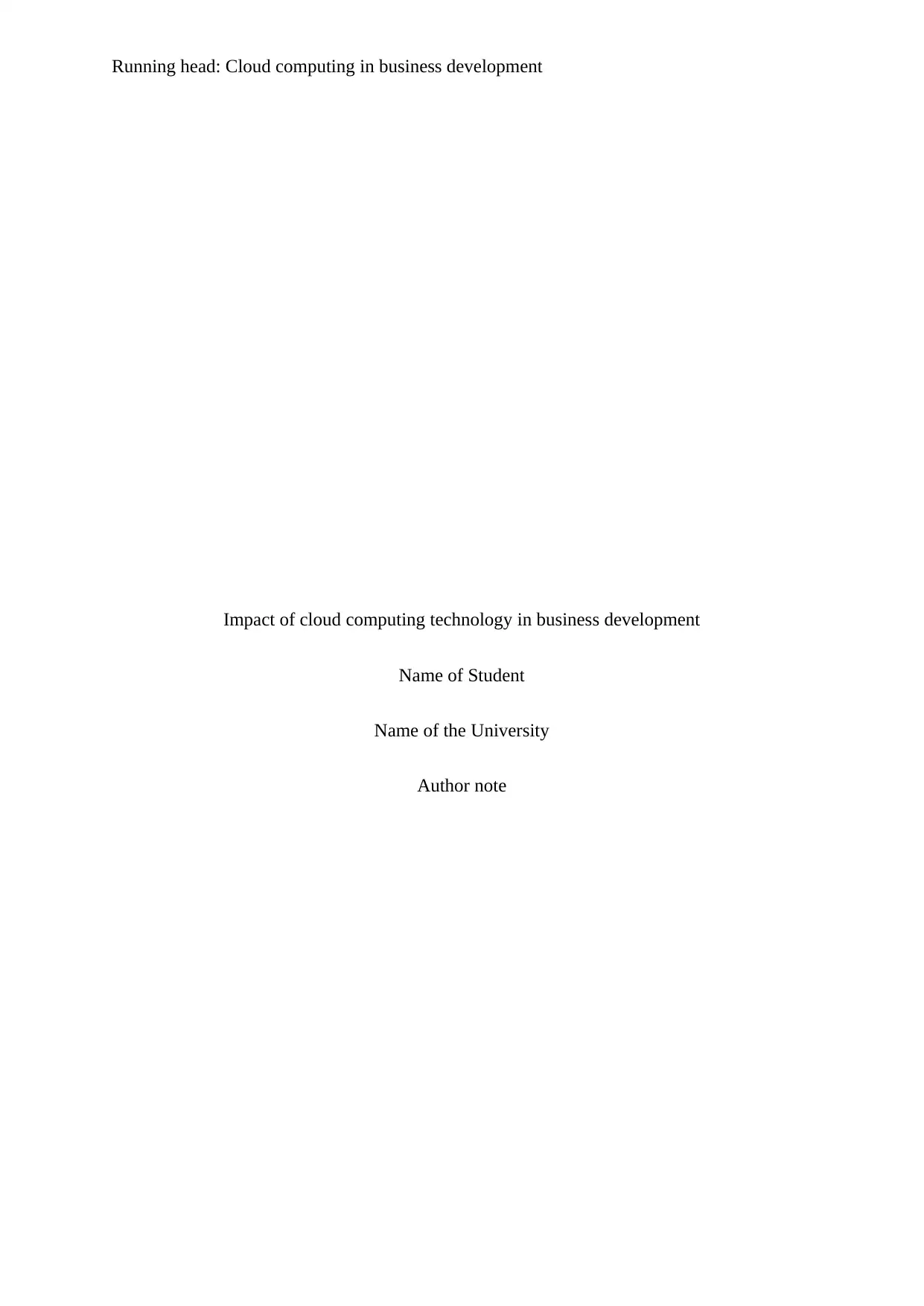
Running head: Cloud computing in business development
Impact of cloud computing technology in business development
Name of Student
Name of the University
Author note
Impact of cloud computing technology in business development
Name of Student
Name of the University
Author note
Paraphrase This Document
Need a fresh take? Get an instant paraphrase of this document with our AI Paraphraser
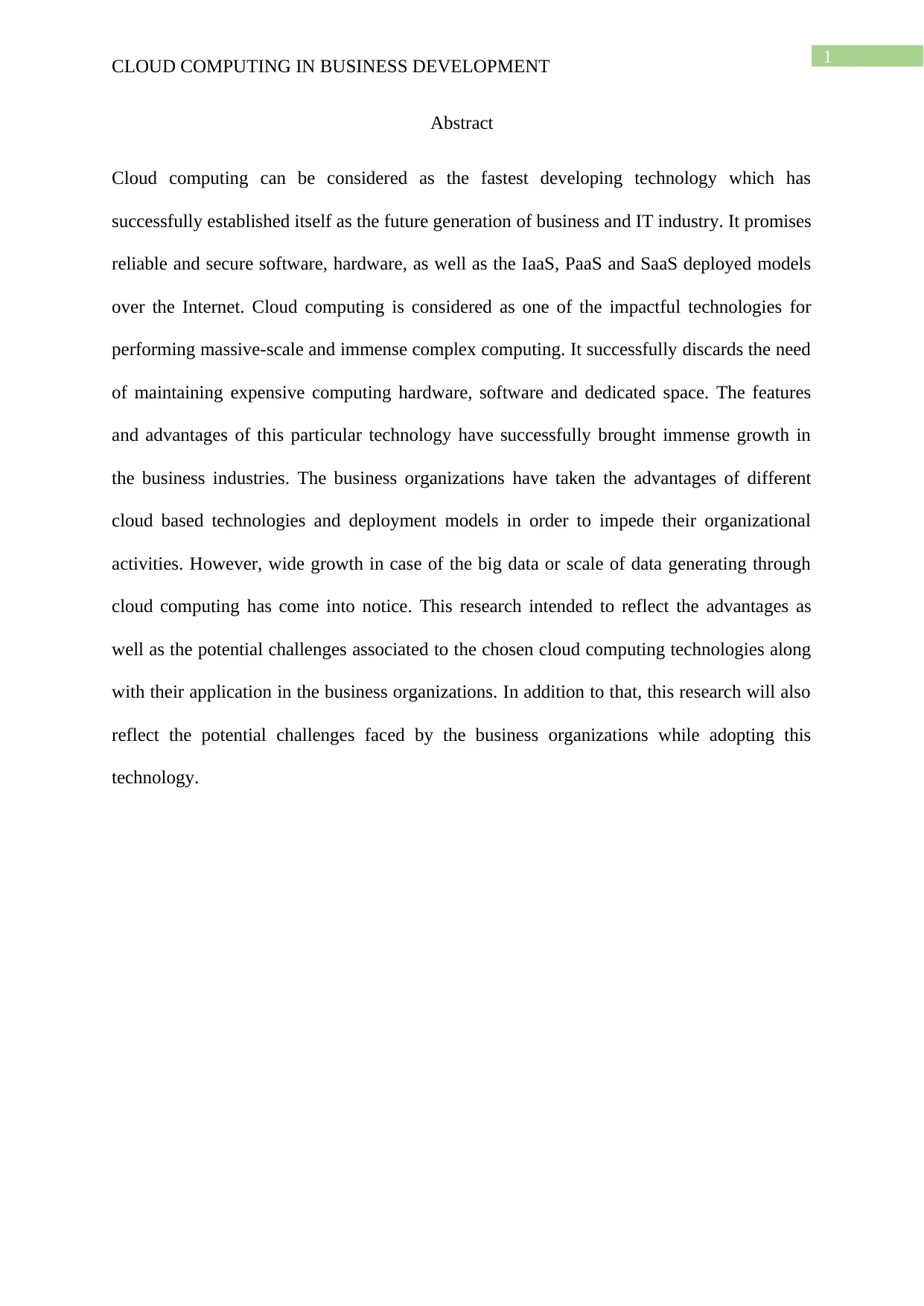
1
CLOUD COMPUTING IN BUSINESS DEVELOPMENT
Abstract
Cloud computing can be considered as the fastest developing technology which has
successfully established itself as the future generation of business and IT industry. It promises
reliable and secure software, hardware, as well as the IaaS, PaaS and SaaS deployed models
over the Internet. Cloud computing is considered as one of the impactful technologies for
performing massive-scale and immense complex computing. It successfully discards the need
of maintaining expensive computing hardware, software and dedicated space. The features
and advantages of this particular technology have successfully brought immense growth in
the business industries. The business organizations have taken the advantages of different
cloud based technologies and deployment models in order to impede their organizational
activities. However, wide growth in case of the big data or scale of data generating through
cloud computing has come into notice. This research intended to reflect the advantages as
well as the potential challenges associated to the chosen cloud computing technologies along
with their application in the business organizations. In addition to that, this research will also
reflect the potential challenges faced by the business organizations while adopting this
technology.
CLOUD COMPUTING IN BUSINESS DEVELOPMENT
Abstract
Cloud computing can be considered as the fastest developing technology which has
successfully established itself as the future generation of business and IT industry. It promises
reliable and secure software, hardware, as well as the IaaS, PaaS and SaaS deployed models
over the Internet. Cloud computing is considered as one of the impactful technologies for
performing massive-scale and immense complex computing. It successfully discards the need
of maintaining expensive computing hardware, software and dedicated space. The features
and advantages of this particular technology have successfully brought immense growth in
the business industries. The business organizations have taken the advantages of different
cloud based technologies and deployment models in order to impede their organizational
activities. However, wide growth in case of the big data or scale of data generating through
cloud computing has come into notice. This research intended to reflect the advantages as
well as the potential challenges associated to the chosen cloud computing technologies along
with their application in the business organizations. In addition to that, this research will also
reflect the potential challenges faced by the business organizations while adopting this
technology.
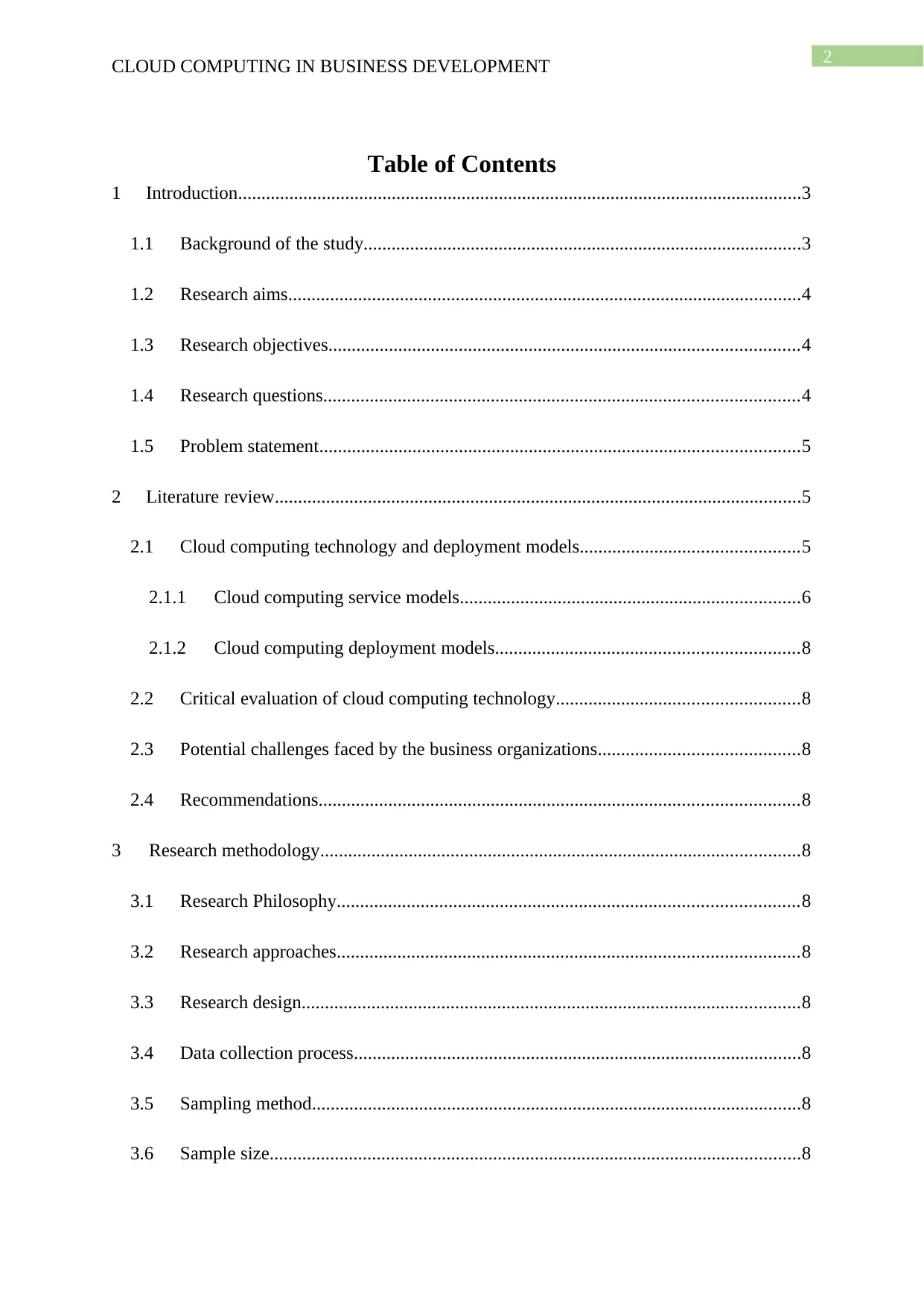
2
CLOUD COMPUTING IN BUSINESS DEVELOPMENT
Table of Contents
1 Introduction.........................................................................................................................3
1.1 Background of the study..............................................................................................3
1.2 Research aims..............................................................................................................4
1.3 Research objectives.....................................................................................................4
1.4 Research questions......................................................................................................4
1.5 Problem statement.......................................................................................................5
2 Literature review.................................................................................................................5
2.1 Cloud computing technology and deployment models...............................................5
2.1.1 Cloud computing service models.........................................................................6
2.1.2 Cloud computing deployment models.................................................................8
2.2 Critical evaluation of cloud computing technology....................................................8
2.3 Potential challenges faced by the business organizations...........................................8
2.4 Recommendations.......................................................................................................8
3 Research methodology.......................................................................................................8
3.1 Research Philosophy...................................................................................................8
3.2 Research approaches...................................................................................................8
3.3 Research design...........................................................................................................8
3.4 Data collection process................................................................................................8
3.5 Sampling method.........................................................................................................8
3.6 Sample size..................................................................................................................8
CLOUD COMPUTING IN BUSINESS DEVELOPMENT
Table of Contents
1 Introduction.........................................................................................................................3
1.1 Background of the study..............................................................................................3
1.2 Research aims..............................................................................................................4
1.3 Research objectives.....................................................................................................4
1.4 Research questions......................................................................................................4
1.5 Problem statement.......................................................................................................5
2 Literature review.................................................................................................................5
2.1 Cloud computing technology and deployment models...............................................5
2.1.1 Cloud computing service models.........................................................................6
2.1.2 Cloud computing deployment models.................................................................8
2.2 Critical evaluation of cloud computing technology....................................................8
2.3 Potential challenges faced by the business organizations...........................................8
2.4 Recommendations.......................................................................................................8
3 Research methodology.......................................................................................................8
3.1 Research Philosophy...................................................................................................8
3.2 Research approaches...................................................................................................8
3.3 Research design...........................................................................................................8
3.4 Data collection process................................................................................................8
3.5 Sampling method.........................................................................................................8
3.6 Sample size..................................................................................................................8
⊘ This is a preview!⊘
Do you want full access?
Subscribe today to unlock all pages.

Trusted by 1+ million students worldwide

3
CLOUD COMPUTING IN BUSINESS DEVELOPMENT
3.7 Expected results of the research..................................................................................8
3.8 Ethical consideration...................................................................................................8
3.9 Limitation of the study................................................................................................8
4 Future scope of the research...............................................................................................8
5 Research schedule..............................................................................................................8
6 Reference............................................................................................................................8
CLOUD COMPUTING IN BUSINESS DEVELOPMENT
3.7 Expected results of the research..................................................................................8
3.8 Ethical consideration...................................................................................................8
3.9 Limitation of the study................................................................................................8
4 Future scope of the research...............................................................................................8
5 Research schedule..............................................................................................................8
6 Reference............................................................................................................................8
Paraphrase This Document
Need a fresh take? Get an instant paraphrase of this document with our AI Paraphraser
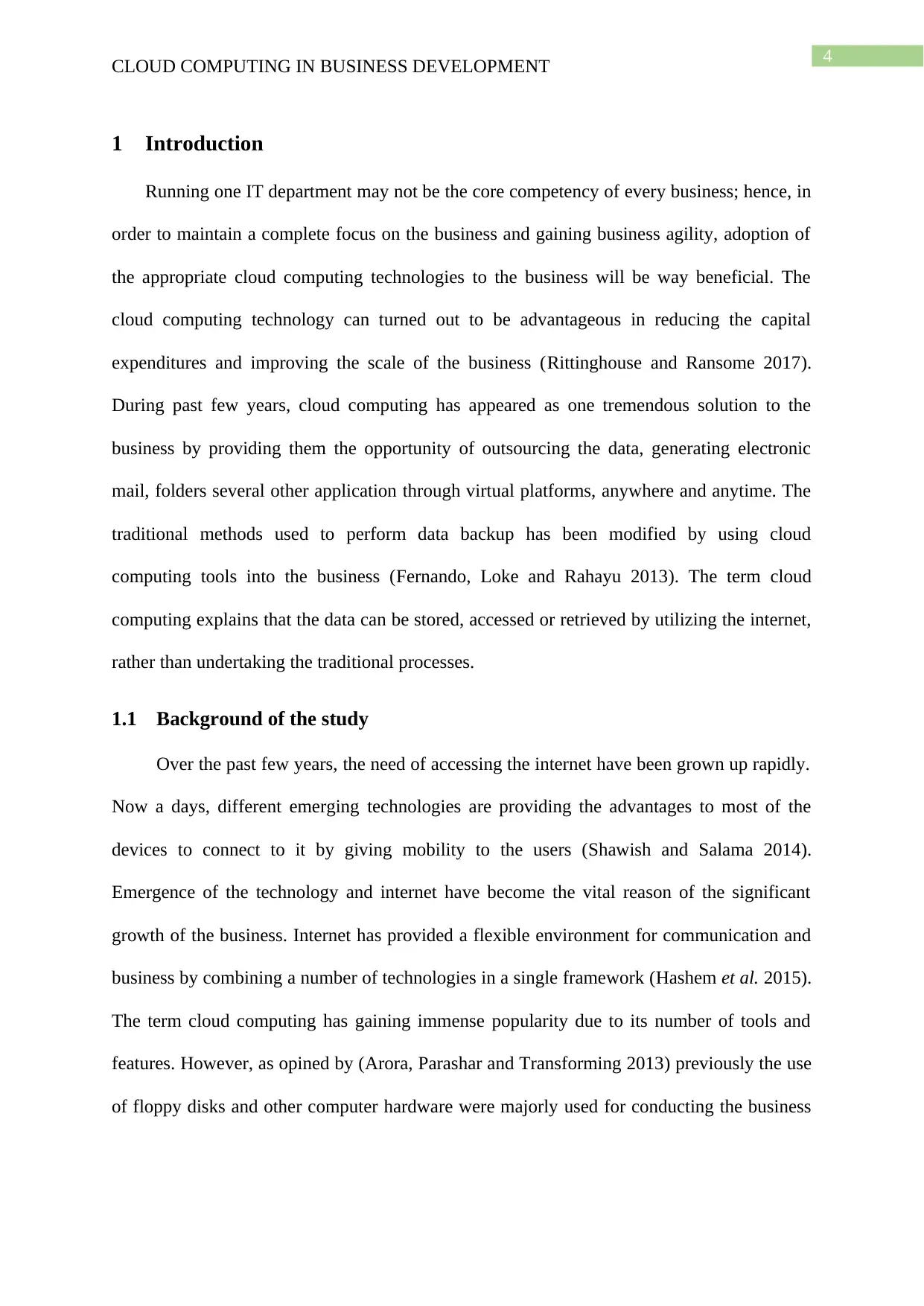
4
CLOUD COMPUTING IN BUSINESS DEVELOPMENT
1 Introduction
Running one IT department may not be the core competency of every business; hence, in
order to maintain a complete focus on the business and gaining business agility, adoption of
the appropriate cloud computing technologies to the business will be way beneficial. The
cloud computing technology can turned out to be advantageous in reducing the capital
expenditures and improving the scale of the business (Rittinghouse and Ransome 2017).
During past few years, cloud computing has appeared as one tremendous solution to the
business by providing them the opportunity of outsourcing the data, generating electronic
mail, folders several other application through virtual platforms, anywhere and anytime. The
traditional methods used to perform data backup has been modified by using cloud
computing tools into the business (Fernando, Loke and Rahayu 2013). The term cloud
computing explains that the data can be stored, accessed or retrieved by utilizing the internet,
rather than undertaking the traditional processes.
1.1 Background of the study
Over the past few years, the need of accessing the internet have been grown up rapidly.
Now a days, different emerging technologies are providing the advantages to most of the
devices to connect to it by giving mobility to the users (Shawish and Salama 2014).
Emergence of the technology and internet have become the vital reason of the significant
growth of the business. Internet has provided a flexible environment for communication and
business by combining a number of technologies in a single framework (Hashem et al. 2015).
The term cloud computing has gaining immense popularity due to its number of tools and
features. However, as opined by (Arora, Parashar and Transforming 2013) previously the use
of floppy disks and other computer hardware were majorly used for conducting the business
CLOUD COMPUTING IN BUSINESS DEVELOPMENT
1 Introduction
Running one IT department may not be the core competency of every business; hence, in
order to maintain a complete focus on the business and gaining business agility, adoption of
the appropriate cloud computing technologies to the business will be way beneficial. The
cloud computing technology can turned out to be advantageous in reducing the capital
expenditures and improving the scale of the business (Rittinghouse and Ransome 2017).
During past few years, cloud computing has appeared as one tremendous solution to the
business by providing them the opportunity of outsourcing the data, generating electronic
mail, folders several other application through virtual platforms, anywhere and anytime. The
traditional methods used to perform data backup has been modified by using cloud
computing tools into the business (Fernando, Loke and Rahayu 2013). The term cloud
computing explains that the data can be stored, accessed or retrieved by utilizing the internet,
rather than undertaking the traditional processes.
1.1 Background of the study
Over the past few years, the need of accessing the internet have been grown up rapidly.
Now a days, different emerging technologies are providing the advantages to most of the
devices to connect to it by giving mobility to the users (Shawish and Salama 2014).
Emergence of the technology and internet have become the vital reason of the significant
growth of the business. Internet has provided a flexible environment for communication and
business by combining a number of technologies in a single framework (Hashem et al. 2015).
The term cloud computing has gaining immense popularity due to its number of tools and
features. However, as opined by (Arora, Parashar and Transforming 2013) previously the use
of floppy disks and other computer hardware were majorly used for conducting the business
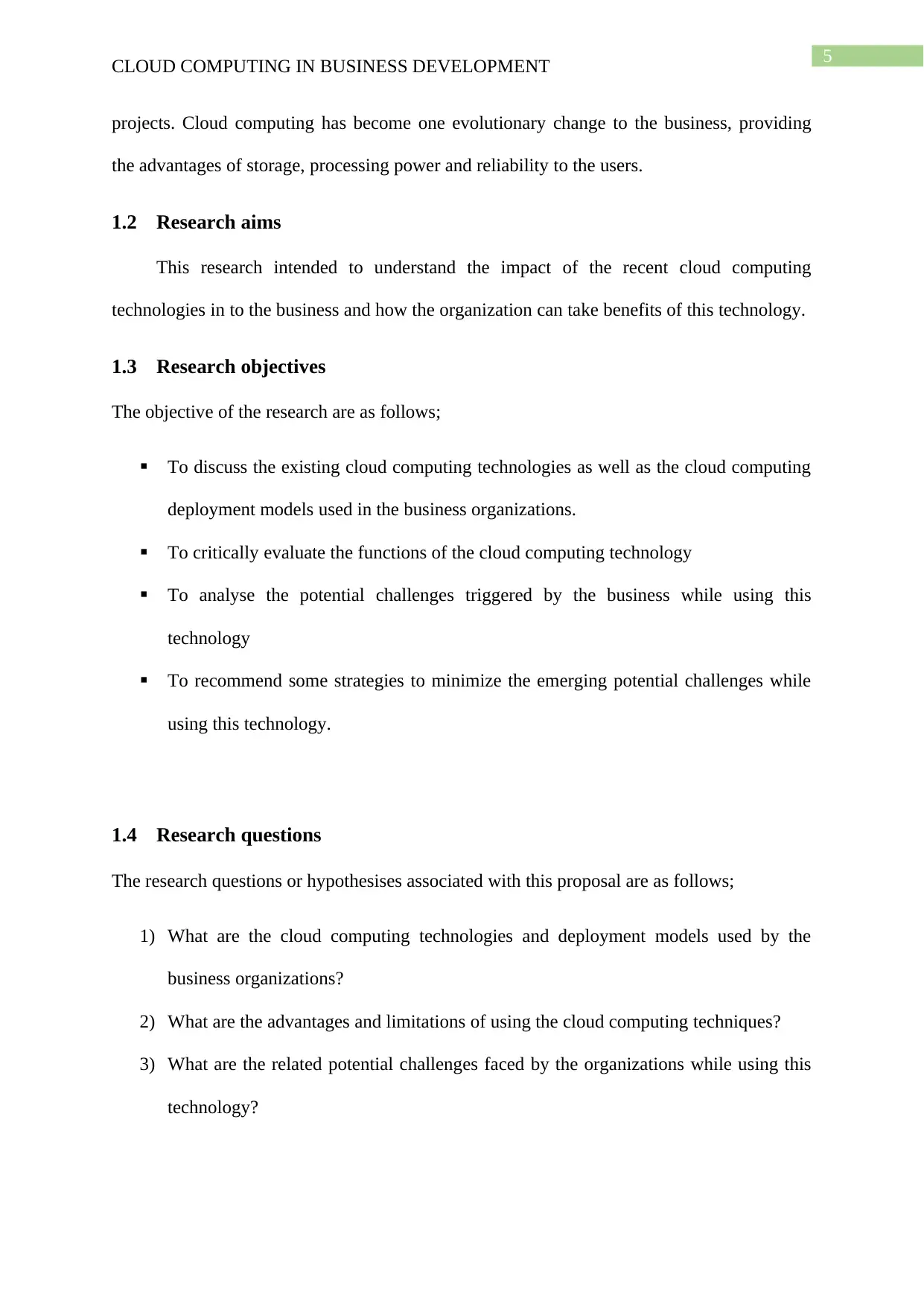
5
CLOUD COMPUTING IN BUSINESS DEVELOPMENT
projects. Cloud computing has become one evolutionary change to the business, providing
the advantages of storage, processing power and reliability to the users.
1.2 Research aims
This research intended to understand the impact of the recent cloud computing
technologies in to the business and how the organization can take benefits of this technology.
1.3 Research objectives
The objective of the research are as follows;
To discuss the existing cloud computing technologies as well as the cloud computing
deployment models used in the business organizations.
To critically evaluate the functions of the cloud computing technology
To analyse the potential challenges triggered by the business while using this
technology
To recommend some strategies to minimize the emerging potential challenges while
using this technology.
1.4 Research questions
The research questions or hypothesises associated with this proposal are as follows;
1) What are the cloud computing technologies and deployment models used by the
business organizations?
2) What are the advantages and limitations of using the cloud computing techniques?
3) What are the related potential challenges faced by the organizations while using this
technology?
CLOUD COMPUTING IN BUSINESS DEVELOPMENT
projects. Cloud computing has become one evolutionary change to the business, providing
the advantages of storage, processing power and reliability to the users.
1.2 Research aims
This research intended to understand the impact of the recent cloud computing
technologies in to the business and how the organization can take benefits of this technology.
1.3 Research objectives
The objective of the research are as follows;
To discuss the existing cloud computing technologies as well as the cloud computing
deployment models used in the business organizations.
To critically evaluate the functions of the cloud computing technology
To analyse the potential challenges triggered by the business while using this
technology
To recommend some strategies to minimize the emerging potential challenges while
using this technology.
1.4 Research questions
The research questions or hypothesises associated with this proposal are as follows;
1) What are the cloud computing technologies and deployment models used by the
business organizations?
2) What are the advantages and limitations of using the cloud computing techniques?
3) What are the related potential challenges faced by the organizations while using this
technology?
⊘ This is a preview!⊘
Do you want full access?
Subscribe today to unlock all pages.

Trusted by 1+ million students worldwide
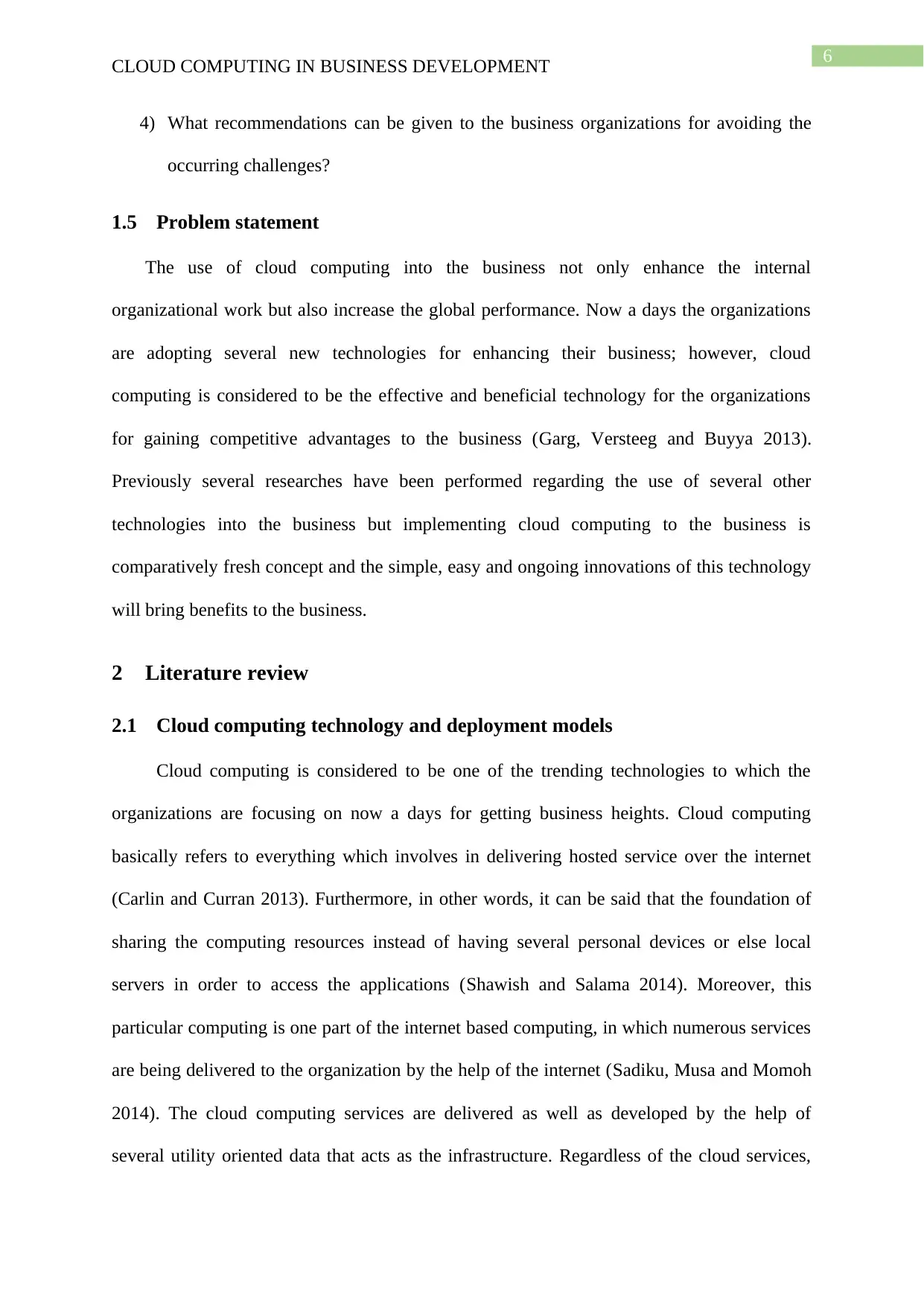
6
CLOUD COMPUTING IN BUSINESS DEVELOPMENT
4) What recommendations can be given to the business organizations for avoiding the
occurring challenges?
1.5 Problem statement
The use of cloud computing into the business not only enhance the internal
organizational work but also increase the global performance. Now a days the organizations
are adopting several new technologies for enhancing their business; however, cloud
computing is considered to be the effective and beneficial technology for the organizations
for gaining competitive advantages to the business (Garg, Versteeg and Buyya 2013).
Previously several researches have been performed regarding the use of several other
technologies into the business but implementing cloud computing to the business is
comparatively fresh concept and the simple, easy and ongoing innovations of this technology
will bring benefits to the business.
2 Literature review
2.1 Cloud computing technology and deployment models
Cloud computing is considered to be one of the trending technologies to which the
organizations are focusing on now a days for getting business heights. Cloud computing
basically refers to everything which involves in delivering hosted service over the internet
(Carlin and Curran 2013). Furthermore, in other words, it can be said that the foundation of
sharing the computing resources instead of having several personal devices or else local
servers in order to access the applications (Shawish and Salama 2014). Moreover, this
particular computing is one part of the internet based computing, in which numerous services
are being delivered to the organization by the help of the internet (Sadiku, Musa and Momoh
2014). The cloud computing services are delivered as well as developed by the help of
several utility oriented data that acts as the infrastructure. Regardless of the cloud services,
CLOUD COMPUTING IN BUSINESS DEVELOPMENT
4) What recommendations can be given to the business organizations for avoiding the
occurring challenges?
1.5 Problem statement
The use of cloud computing into the business not only enhance the internal
organizational work but also increase the global performance. Now a days the organizations
are adopting several new technologies for enhancing their business; however, cloud
computing is considered to be the effective and beneficial technology for the organizations
for gaining competitive advantages to the business (Garg, Versteeg and Buyya 2013).
Previously several researches have been performed regarding the use of several other
technologies into the business but implementing cloud computing to the business is
comparatively fresh concept and the simple, easy and ongoing innovations of this technology
will bring benefits to the business.
2 Literature review
2.1 Cloud computing technology and deployment models
Cloud computing is considered to be one of the trending technologies to which the
organizations are focusing on now a days for getting business heights. Cloud computing
basically refers to everything which involves in delivering hosted service over the internet
(Carlin and Curran 2013). Furthermore, in other words, it can be said that the foundation of
sharing the computing resources instead of having several personal devices or else local
servers in order to access the applications (Shawish and Salama 2014). Moreover, this
particular computing is one part of the internet based computing, in which numerous services
are being delivered to the organization by the help of the internet (Sadiku, Musa and Momoh
2014). The cloud computing services are delivered as well as developed by the help of
several utility oriented data that acts as the infrastructure. Regardless of the cloud services,
Paraphrase This Document
Need a fresh take? Get an instant paraphrase of this document with our AI Paraphraser
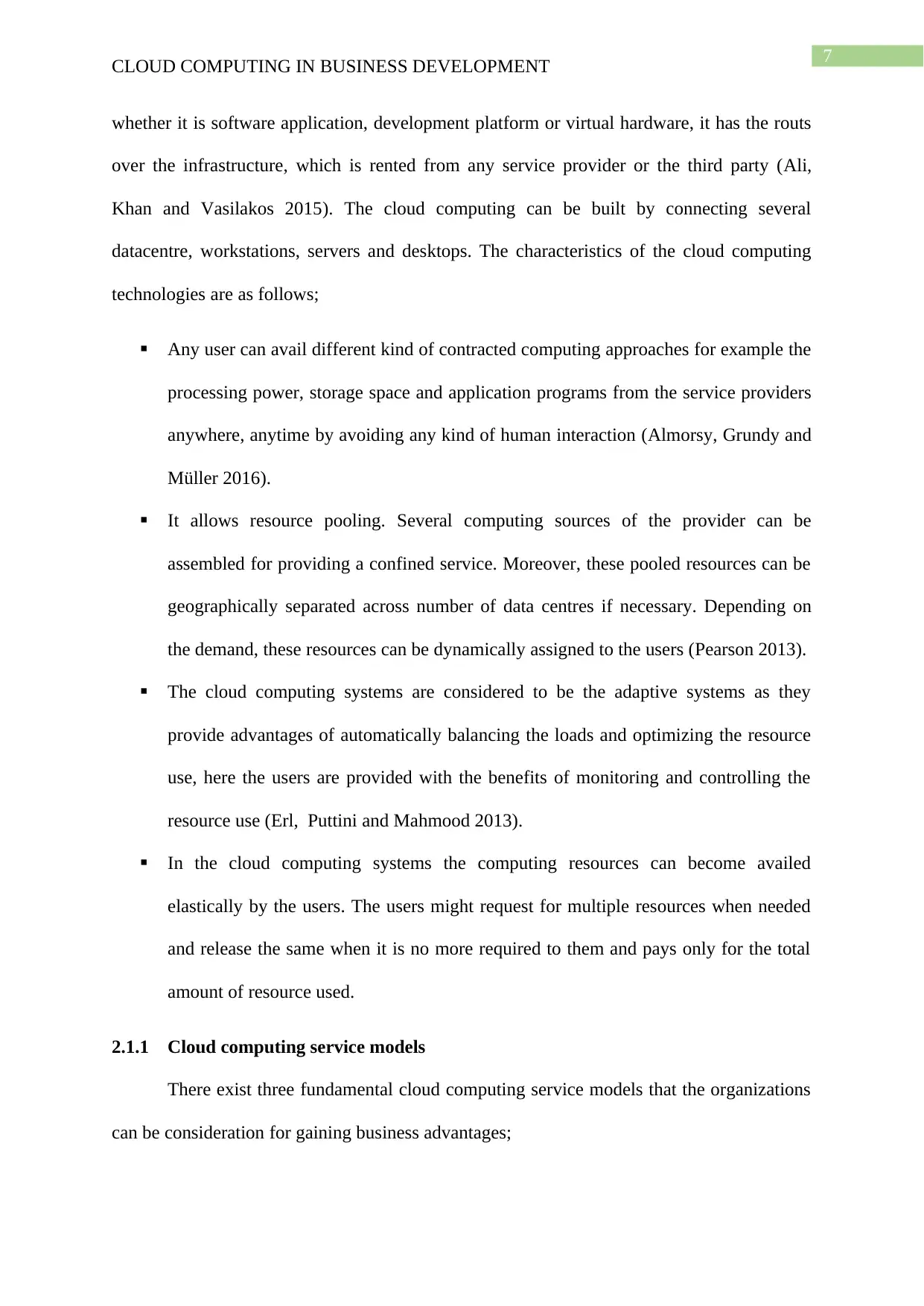
7
CLOUD COMPUTING IN BUSINESS DEVELOPMENT
whether it is software application, development platform or virtual hardware, it has the routs
over the infrastructure, which is rented from any service provider or the third party (Ali,
Khan and Vasilakos 2015). The cloud computing can be built by connecting several
datacentre, workstations, servers and desktops. The characteristics of the cloud computing
technologies are as follows;
Any user can avail different kind of contracted computing approaches for example the
processing power, storage space and application programs from the service providers
anywhere, anytime by avoiding any kind of human interaction (Almorsy, Grundy and
Müller 2016).
It allows resource pooling. Several computing sources of the provider can be
assembled for providing a confined service. Moreover, these pooled resources can be
geographically separated across number of data centres if necessary. Depending on
the demand, these resources can be dynamically assigned to the users (Pearson 2013).
The cloud computing systems are considered to be the adaptive systems as they
provide advantages of automatically balancing the loads and optimizing the resource
use, here the users are provided with the benefits of monitoring and controlling the
resource use (Erl, Puttini and Mahmood 2013).
In the cloud computing systems the computing resources can become availed
elastically by the users. The users might request for multiple resources when needed
and release the same when it is no more required to them and pays only for the total
amount of resource used.
2.1.1 Cloud computing service models
There exist three fundamental cloud computing service models that the organizations
can be consideration for gaining business advantages;
CLOUD COMPUTING IN BUSINESS DEVELOPMENT
whether it is software application, development platform or virtual hardware, it has the routs
over the infrastructure, which is rented from any service provider or the third party (Ali,
Khan and Vasilakos 2015). The cloud computing can be built by connecting several
datacentre, workstations, servers and desktops. The characteristics of the cloud computing
technologies are as follows;
Any user can avail different kind of contracted computing approaches for example the
processing power, storage space and application programs from the service providers
anywhere, anytime by avoiding any kind of human interaction (Almorsy, Grundy and
Müller 2016).
It allows resource pooling. Several computing sources of the provider can be
assembled for providing a confined service. Moreover, these pooled resources can be
geographically separated across number of data centres if necessary. Depending on
the demand, these resources can be dynamically assigned to the users (Pearson 2013).
The cloud computing systems are considered to be the adaptive systems as they
provide advantages of automatically balancing the loads and optimizing the resource
use, here the users are provided with the benefits of monitoring and controlling the
resource use (Erl, Puttini and Mahmood 2013).
In the cloud computing systems the computing resources can become availed
elastically by the users. The users might request for multiple resources when needed
and release the same when it is no more required to them and pays only for the total
amount of resource used.
2.1.1 Cloud computing service models
There exist three fundamental cloud computing service models that the organizations
can be consideration for gaining business advantages;
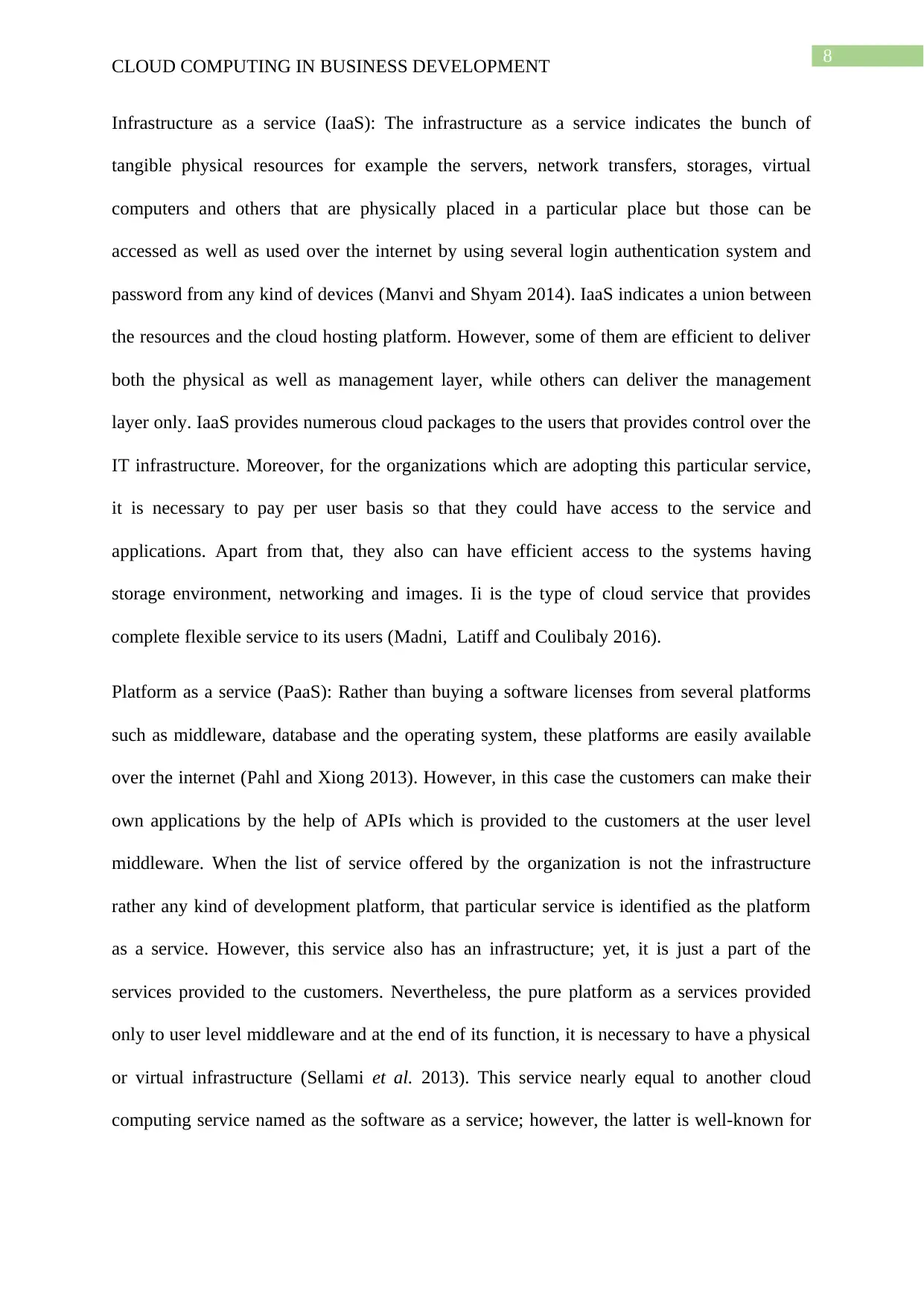
8
CLOUD COMPUTING IN BUSINESS DEVELOPMENT
Infrastructure as a service (IaaS): The infrastructure as a service indicates the bunch of
tangible physical resources for example the servers, network transfers, storages, virtual
computers and others that are physically placed in a particular place but those can be
accessed as well as used over the internet by using several login authentication system and
password from any kind of devices (Manvi and Shyam 2014). IaaS indicates a union between
the resources and the cloud hosting platform. However, some of them are efficient to deliver
both the physical as well as management layer, while others can deliver the management
layer only. IaaS provides numerous cloud packages to the users that provides control over the
IT infrastructure. Moreover, for the organizations which are adopting this particular service,
it is necessary to pay per user basis so that they could have access to the service and
applications. Apart from that, they also can have efficient access to the systems having
storage environment, networking and images. Ii is the type of cloud service that provides
complete flexible service to its users (Madni, Latiff and Coulibaly 2016).
Platform as a service (PaaS): Rather than buying a software licenses from several platforms
such as middleware, database and the operating system, these platforms are easily available
over the internet (Pahl and Xiong 2013). However, in this case the customers can make their
own applications by the help of APIs which is provided to the customers at the user level
middleware. When the list of service offered by the organization is not the infrastructure
rather any kind of development platform, that particular service is identified as the platform
as a service. However, this service also has an infrastructure; yet, it is just a part of the
services provided to the customers. Nevertheless, the pure platform as a services provided
only to user level middleware and at the end of its function, it is necessary to have a physical
or virtual infrastructure (Sellami et al. 2013). This service nearly equal to another cloud
computing service named as the software as a service; however, the latter is well-known for
CLOUD COMPUTING IN BUSINESS DEVELOPMENT
Infrastructure as a service (IaaS): The infrastructure as a service indicates the bunch of
tangible physical resources for example the servers, network transfers, storages, virtual
computers and others that are physically placed in a particular place but those can be
accessed as well as used over the internet by using several login authentication system and
password from any kind of devices (Manvi and Shyam 2014). IaaS indicates a union between
the resources and the cloud hosting platform. However, some of them are efficient to deliver
both the physical as well as management layer, while others can deliver the management
layer only. IaaS provides numerous cloud packages to the users that provides control over the
IT infrastructure. Moreover, for the organizations which are adopting this particular service,
it is necessary to pay per user basis so that they could have access to the service and
applications. Apart from that, they also can have efficient access to the systems having
storage environment, networking and images. Ii is the type of cloud service that provides
complete flexible service to its users (Madni, Latiff and Coulibaly 2016).
Platform as a service (PaaS): Rather than buying a software licenses from several platforms
such as middleware, database and the operating system, these platforms are easily available
over the internet (Pahl and Xiong 2013). However, in this case the customers can make their
own applications by the help of APIs which is provided to the customers at the user level
middleware. When the list of service offered by the organization is not the infrastructure
rather any kind of development platform, that particular service is identified as the platform
as a service. However, this service also has an infrastructure; yet, it is just a part of the
services provided to the customers. Nevertheless, the pure platform as a services provided
only to user level middleware and at the end of its function, it is necessary to have a physical
or virtual infrastructure (Sellami et al. 2013). This service nearly equal to another cloud
computing service named as the software as a service; however, the latter is well-known for
⊘ This is a preview!⊘
Do you want full access?
Subscribe today to unlock all pages.

Trusted by 1+ million students worldwide
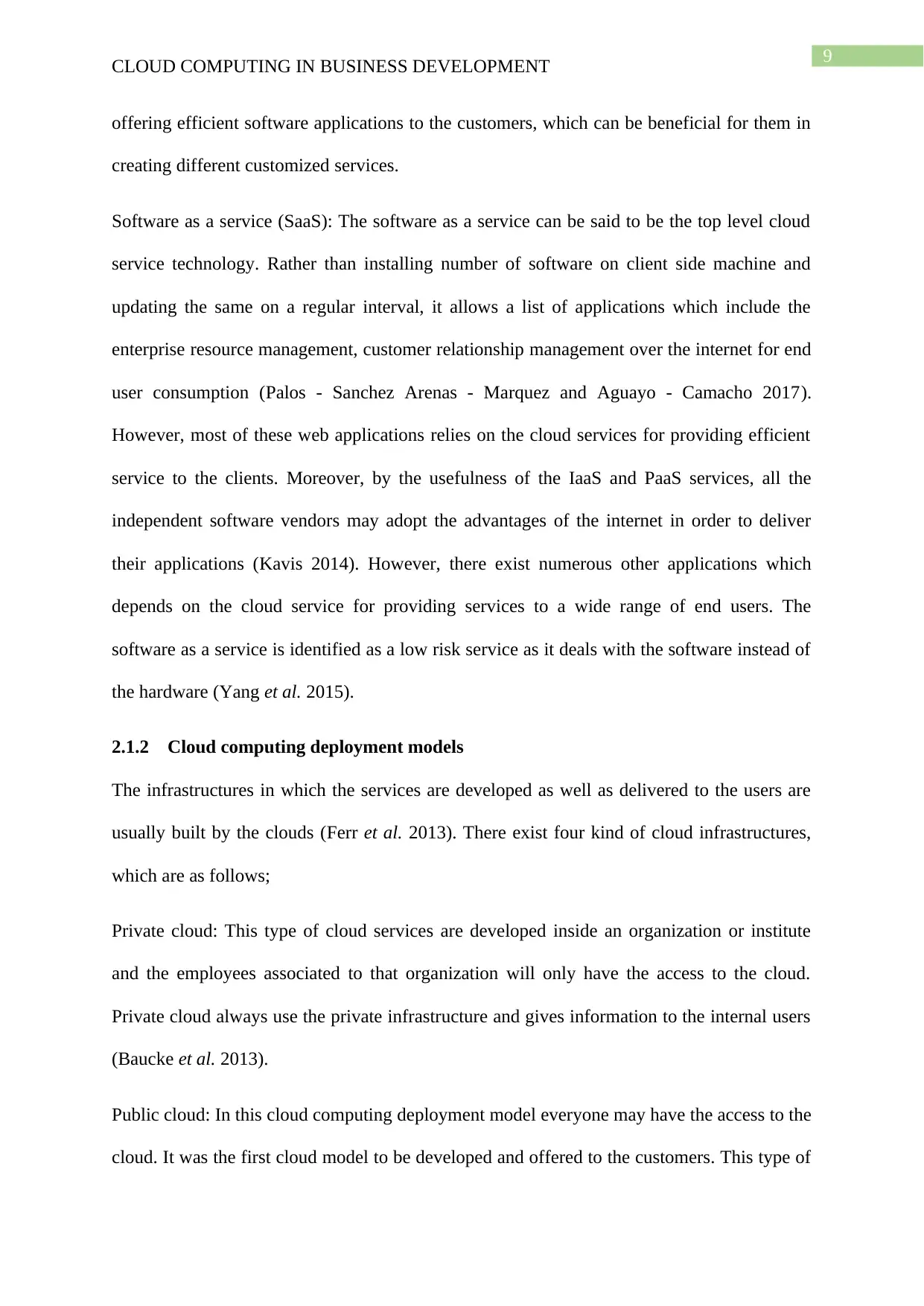
9
CLOUD COMPUTING IN BUSINESS DEVELOPMENT
offering efficient software applications to the customers, which can be beneficial for them in
creating different customized services.
Software as a service (SaaS): The software as a service can be said to be the top level cloud
service technology. Rather than installing number of software on client side machine and
updating the same on a regular interval, it allows a list of applications which include the
enterprise resource management, customer relationship management over the internet for end
user consumption (Palos - Sanchez Arenas - Marquez and Aguayo - Camacho 2017).
However, most of these web applications relies on the cloud services for providing efficient
service to the clients. Moreover, by the usefulness of the IaaS and PaaS services, all the
independent software vendors may adopt the advantages of the internet in order to deliver
their applications (Kavis 2014). However, there exist numerous other applications which
depends on the cloud service for providing services to a wide range of end users. The
software as a service is identified as a low risk service as it deals with the software instead of
the hardware (Yang et al. 2015).
2.1.2 Cloud computing deployment models
The infrastructures in which the services are developed as well as delivered to the users are
usually built by the clouds (Ferr et al. 2013). There exist four kind of cloud infrastructures,
which are as follows;
Private cloud: This type of cloud services are developed inside an organization or institute
and the employees associated to that organization will only have the access to the cloud.
Private cloud always use the private infrastructure and gives information to the internal users
(Baucke et al. 2013).
Public cloud: In this cloud computing deployment model everyone may have the access to the
cloud. It was the first cloud model to be developed and offered to the customers. This type of
CLOUD COMPUTING IN BUSINESS DEVELOPMENT
offering efficient software applications to the customers, which can be beneficial for them in
creating different customized services.
Software as a service (SaaS): The software as a service can be said to be the top level cloud
service technology. Rather than installing number of software on client side machine and
updating the same on a regular interval, it allows a list of applications which include the
enterprise resource management, customer relationship management over the internet for end
user consumption (Palos - Sanchez Arenas - Marquez and Aguayo - Camacho 2017).
However, most of these web applications relies on the cloud services for providing efficient
service to the clients. Moreover, by the usefulness of the IaaS and PaaS services, all the
independent software vendors may adopt the advantages of the internet in order to deliver
their applications (Kavis 2014). However, there exist numerous other applications which
depends on the cloud service for providing services to a wide range of end users. The
software as a service is identified as a low risk service as it deals with the software instead of
the hardware (Yang et al. 2015).
2.1.2 Cloud computing deployment models
The infrastructures in which the services are developed as well as delivered to the users are
usually built by the clouds (Ferr et al. 2013). There exist four kind of cloud infrastructures,
which are as follows;
Private cloud: This type of cloud services are developed inside an organization or institute
and the employees associated to that organization will only have the access to the cloud.
Private cloud always use the private infrastructure and gives information to the internal users
(Baucke et al. 2013).
Public cloud: In this cloud computing deployment model everyone may have the access to the
cloud. It was the first cloud model to be developed and offered to the customers. This type of
Paraphrase This Document
Need a fresh take? Get an instant paraphrase of this document with our AI Paraphraser
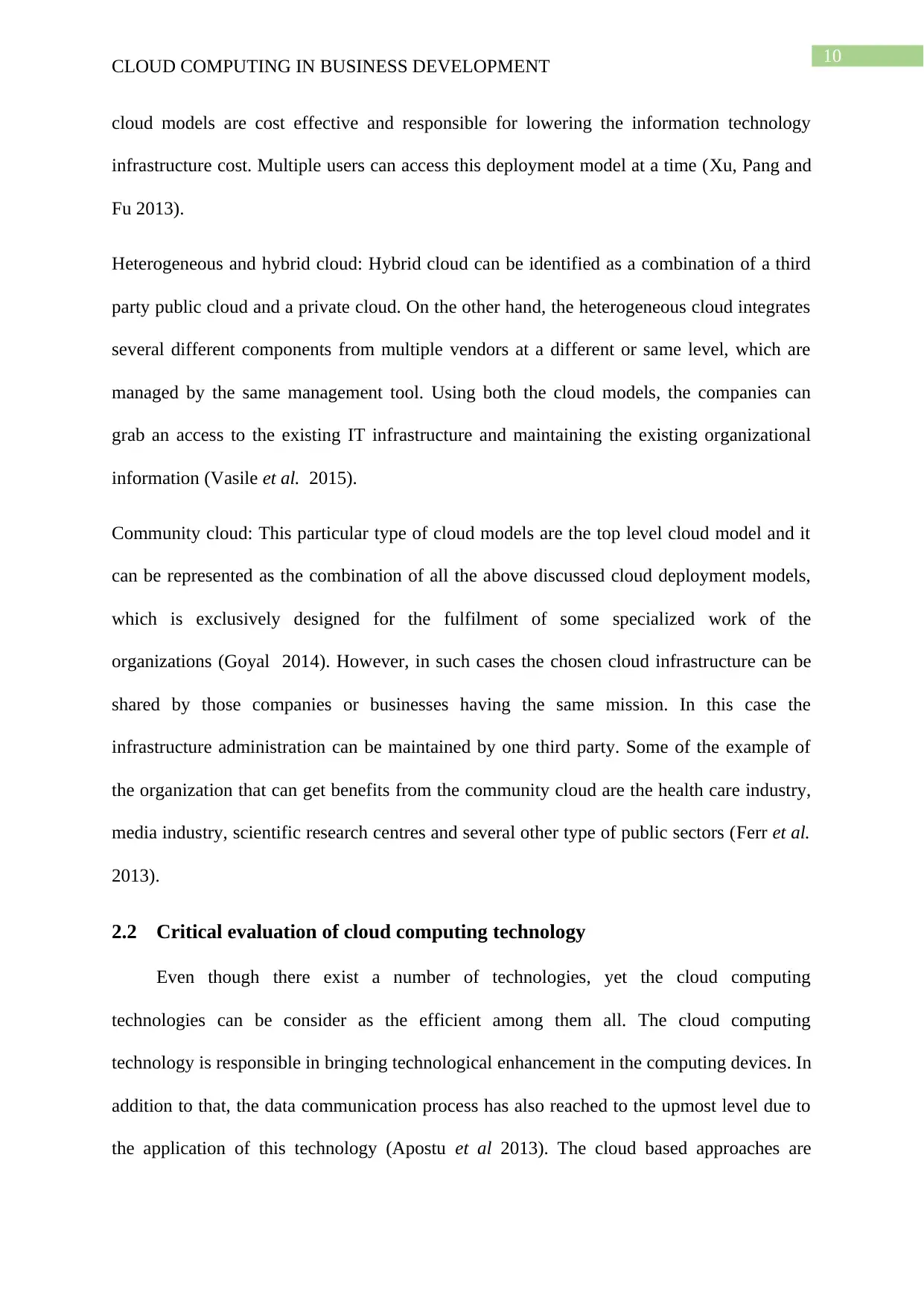
10
CLOUD COMPUTING IN BUSINESS DEVELOPMENT
cloud models are cost effective and responsible for lowering the information technology
infrastructure cost. Multiple users can access this deployment model at a time (Xu, Pang and
Fu 2013).
Heterogeneous and hybrid cloud: Hybrid cloud can be identified as a combination of a third
party public cloud and a private cloud. On the other hand, the heterogeneous cloud integrates
several different components from multiple vendors at a different or same level, which are
managed by the same management tool. Using both the cloud models, the companies can
grab an access to the existing IT infrastructure and maintaining the existing organizational
information (Vasile et al. 2015).
Community cloud: This particular type of cloud models are the top level cloud model and it
can be represented as the combination of all the above discussed cloud deployment models,
which is exclusively designed for the fulfilment of some specialized work of the
organizations (Goyal 2014). However, in such cases the chosen cloud infrastructure can be
shared by those companies or businesses having the same mission. In this case the
infrastructure administration can be maintained by one third party. Some of the example of
the organization that can get benefits from the community cloud are the health care industry,
media industry, scientific research centres and several other type of public sectors (Ferr et al.
2013).
2.2 Critical evaluation of cloud computing technology
Even though there exist a number of technologies, yet the cloud computing
technologies can be consider as the efficient among them all. The cloud computing
technology is responsible in bringing technological enhancement in the computing devices. In
addition to that, the data communication process has also reached to the upmost level due to
the application of this technology (Apostu et al 2013). The cloud based approaches are
CLOUD COMPUTING IN BUSINESS DEVELOPMENT
cloud models are cost effective and responsible for lowering the information technology
infrastructure cost. Multiple users can access this deployment model at a time (Xu, Pang and
Fu 2013).
Heterogeneous and hybrid cloud: Hybrid cloud can be identified as a combination of a third
party public cloud and a private cloud. On the other hand, the heterogeneous cloud integrates
several different components from multiple vendors at a different or same level, which are
managed by the same management tool. Using both the cloud models, the companies can
grab an access to the existing IT infrastructure and maintaining the existing organizational
information (Vasile et al. 2015).
Community cloud: This particular type of cloud models are the top level cloud model and it
can be represented as the combination of all the above discussed cloud deployment models,
which is exclusively designed for the fulfilment of some specialized work of the
organizations (Goyal 2014). However, in such cases the chosen cloud infrastructure can be
shared by those companies or businesses having the same mission. In this case the
infrastructure administration can be maintained by one third party. Some of the example of
the organization that can get benefits from the community cloud are the health care industry,
media industry, scientific research centres and several other type of public sectors (Ferr et al.
2013).
2.2 Critical evaluation of cloud computing technology
Even though there exist a number of technologies, yet the cloud computing
technologies can be consider as the efficient among them all. The cloud computing
technology is responsible in bringing technological enhancement in the computing devices. In
addition to that, the data communication process has also reached to the upmost level due to
the application of this technology (Apostu et al 2013). The cloud based approaches are
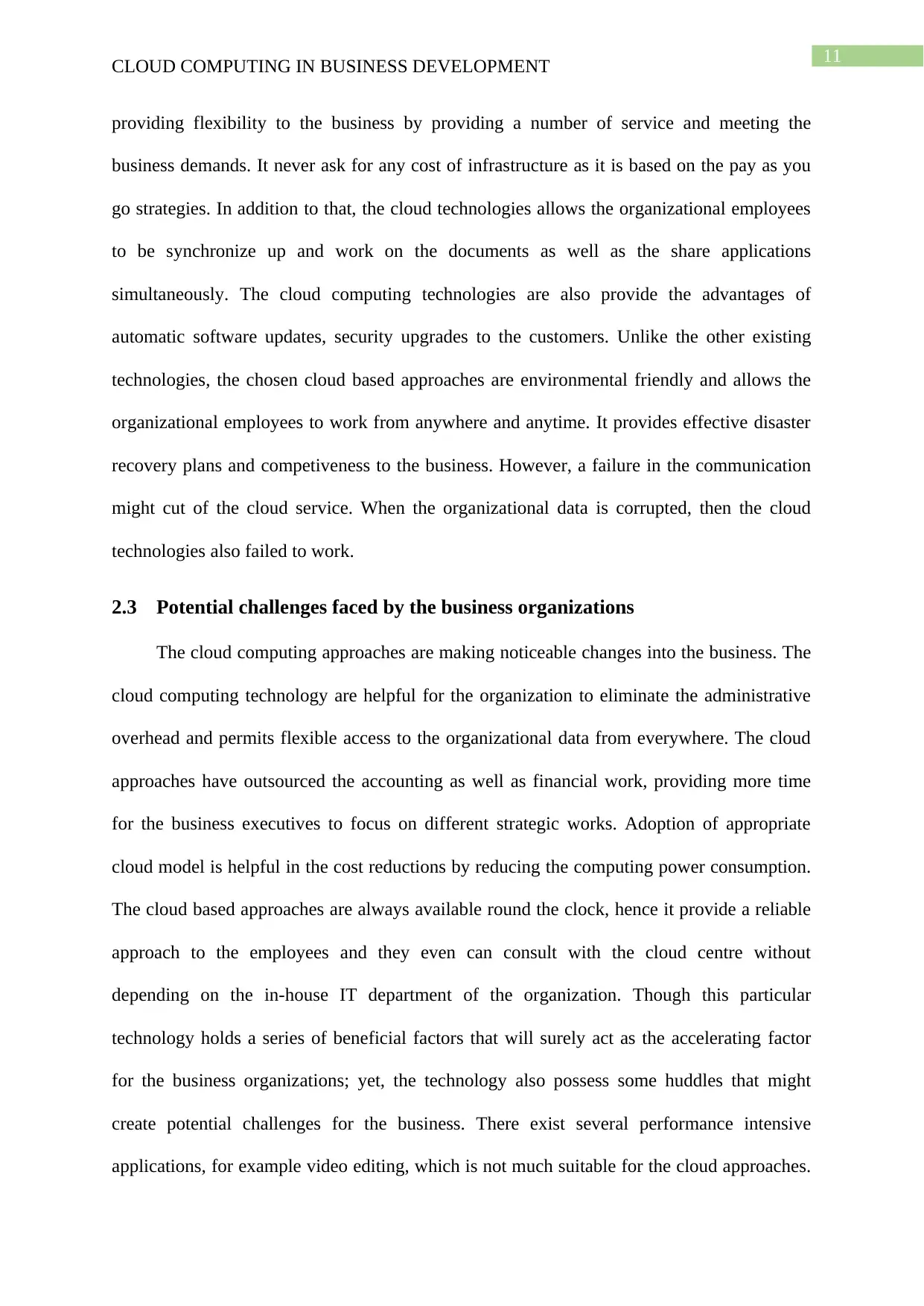
11
CLOUD COMPUTING IN BUSINESS DEVELOPMENT
providing flexibility to the business by providing a number of service and meeting the
business demands. It never ask for any cost of infrastructure as it is based on the pay as you
go strategies. In addition to that, the cloud technologies allows the organizational employees
to be synchronize up and work on the documents as well as the share applications
simultaneously. The cloud computing technologies are also provide the advantages of
automatic software updates, security upgrades to the customers. Unlike the other existing
technologies, the chosen cloud based approaches are environmental friendly and allows the
organizational employees to work from anywhere and anytime. It provides effective disaster
recovery plans and competiveness to the business. However, a failure in the communication
might cut of the cloud service. When the organizational data is corrupted, then the cloud
technologies also failed to work.
2.3 Potential challenges faced by the business organizations
The cloud computing approaches are making noticeable changes into the business. The
cloud computing technology are helpful for the organization to eliminate the administrative
overhead and permits flexible access to the organizational data from everywhere. The cloud
approaches have outsourced the accounting as well as financial work, providing more time
for the business executives to focus on different strategic works. Adoption of appropriate
cloud model is helpful in the cost reductions by reducing the computing power consumption.
The cloud based approaches are always available round the clock, hence it provide a reliable
approach to the employees and they even can consult with the cloud centre without
depending on the in-house IT department of the organization. Though this particular
technology holds a series of beneficial factors that will surely act as the accelerating factor
for the business organizations; yet, the technology also possess some huddles that might
create potential challenges for the business. There exist several performance intensive
applications, for example video editing, which is not much suitable for the cloud approaches.
CLOUD COMPUTING IN BUSINESS DEVELOPMENT
providing flexibility to the business by providing a number of service and meeting the
business demands. It never ask for any cost of infrastructure as it is based on the pay as you
go strategies. In addition to that, the cloud technologies allows the organizational employees
to be synchronize up and work on the documents as well as the share applications
simultaneously. The cloud computing technologies are also provide the advantages of
automatic software updates, security upgrades to the customers. Unlike the other existing
technologies, the chosen cloud based approaches are environmental friendly and allows the
organizational employees to work from anywhere and anytime. It provides effective disaster
recovery plans and competiveness to the business. However, a failure in the communication
might cut of the cloud service. When the organizational data is corrupted, then the cloud
technologies also failed to work.
2.3 Potential challenges faced by the business organizations
The cloud computing approaches are making noticeable changes into the business. The
cloud computing technology are helpful for the organization to eliminate the administrative
overhead and permits flexible access to the organizational data from everywhere. The cloud
approaches have outsourced the accounting as well as financial work, providing more time
for the business executives to focus on different strategic works. Adoption of appropriate
cloud model is helpful in the cost reductions by reducing the computing power consumption.
The cloud based approaches are always available round the clock, hence it provide a reliable
approach to the employees and they even can consult with the cloud centre without
depending on the in-house IT department of the organization. Though this particular
technology holds a series of beneficial factors that will surely act as the accelerating factor
for the business organizations; yet, the technology also possess some huddles that might
create potential challenges for the business. There exist several performance intensive
applications, for example video editing, which is not much suitable for the cloud approaches.
⊘ This is a preview!⊘
Do you want full access?
Subscribe today to unlock all pages.

Trusted by 1+ million students worldwide
1 out of 25
Related Documents
Your All-in-One AI-Powered Toolkit for Academic Success.
+13062052269
info@desklib.com
Available 24*7 on WhatsApp / Email
![[object Object]](/_next/static/media/star-bottom.7253800d.svg)
Unlock your academic potential
Copyright © 2020–2025 A2Z Services. All Rights Reserved. Developed and managed by ZUCOL.



